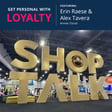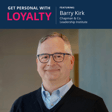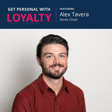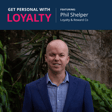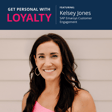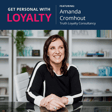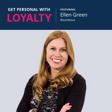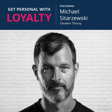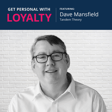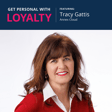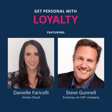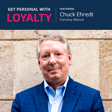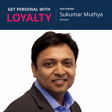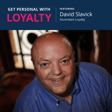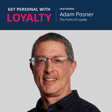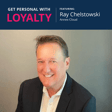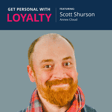Become a Creator today!Start creating today - Share your story with the world!
Start for free
00:00:00
00:00:01

Key Metrics and KPIs for Successful Gamification (ft. Aaron Lobliner)
For our conversations about gamification, we had a meeting with Aaron Lobliner, Chief Client Officer at CataBoom. This conversation revealed the top metrics brands track with gamification, along with tips on aligning games to your brand, crafting games for all ages, and seamlessly integrating them into campaigns. Learn the golden rule of gamification success to win!
Transcript
Introduction to Personalized Loyalty
00:00:10
Speaker
Get Personal with Loyalty, where we're discussing using loyalty to deliver personalized, relevant customer experiences. Hello, everybody. Welcome to the next episode of Get Personal with Loyalty.
Guest Introduction: Aaron Loveliner
00:00:22
Speaker
I'm your host, Aaron Reese, and today I'm here with Aaron Loveliner from Cataboom. He is the chief client officer. Welcome, Aaron. Hey, good. Happy, happy talking. This is exciting. I always love finding ways to talk about marketing, loyalty and gamification, of course.
00:00:39
Speaker
super excited to have you here. And yes, the topic we wanted to cover today is gamification, which I know is near and dear to your heart. That's a truism. So it's something I've been doing in one way, shape or form for I think over 15 years now.
Career Journey: Agency to PrizeLogic
00:00:54
Speaker
Wow. Wow. Well, let's start there. How did, how did you get into this space and feel free to share where you were before stumbling into gamification and such, but love to hear the background.
00:01:05
Speaker
Yeah, I was on the agency side years ago. We're going back again 15, 20 years ago and I was on the agency side and without going into all the details, there was an opportunity and a connection to the ownership of that agency on a company that was kind of just starting off end up being prize logic. So a lot of people have heard of prize logic in the marketplace. So I had the blessing of being able to help build and grow prize logic over almost 14 year period.
00:01:33
Speaker
which ended about two years ago.
Transition to Cataboom
00:01:36
Speaker
For those that don't know, PrizeLogic worked with direct clients and different technology and agency partners building out promotions and different versions of gamification for things like McDonald's Monopoly and Subway and Disney and Pepsi and Samsung for all these years. We built up this repertoire and this wonderful, wonderful business.
00:01:58
Speaker
Long story short, after a couple of sales, the company went in a different direction. I did something else for about a year. I helped a friend, and then I was trying to find my next thing. It was actually a reference for one of my former team members. All of a sudden, the skies opened up, and the angels started singing, and this was just this amazing opportunity, a company I hadn't known much about. Ultimately, the company with a
00:02:25
Speaker
a gamification and pricing promotion platform that had been built and honed for 10 years and working with some of the best brands in the world and was really just a secret. It's a company that grew over that time period based on word of mouth. Really, I've been able to come in over the last year and my job is to help really drive awareness. That's the company's biggest challenge is awareness. Part of the reason we're talking. That's the quick background. It's really fun. Let's dig into that a little bit more.
Cataboom's Customizable Gamification Solutions
00:02:55
Speaker
What I remembered of prize logic was the promotions piece. In my mind, I think it remember thinking more sweepstakes, but it out of boom is really is taken maybe what prize logic did and really bringing it more into the century and much more digital approach to games and promotions.
00:03:15
Speaker
That'd be accurate. That's pretty spot on. I mean, the reality is, like Surprise Logic, we would do a lot more very custom work, or it came across as custom. The difference is, at Cataboom, is there's a platform that actually does the heavy lifting. So speed to market.
00:03:29
Speaker
efficiency boast in time and cost because the platform does it. We have a library of over 200 game mechanics. We have an instant win and sweet stakes pricing platform and all these different different tools that can be construct. We can construct engagements essentially like Lego blocks.
00:03:47
Speaker
And so it can be a lot more customizable versus custom. And so that allows us to do very, very similar or even more intricate campaigns versus what I did at the other place, but in a lot faster, more efficient way. And so because it's a platform, we have about half of our clients that are actually self-serve, some very large scale things, and about half of them we add different services on top. And so that's a big difference too, is the ability for clients to be self-serve.
00:04:15
Speaker
Well, that's great. Well, and as we know, everybody wants to be. Time is money today. Let's dig a little further.
Driving Behavior with Gamification
00:04:23
Speaker
So, gamification I think is where you guys are focused. And you mentioned that there's different kinds of game mechanics that you guys are offering that are a bit off the shelf as part of the platform. How do you define gamification when you're talking to customers? So when you're talking to a brand,
00:04:41
Speaker
What is it that you're saying and how do you talk about how the strategy helps them? Yeah, I love that. I'm going to kind of go up to the maybe 30,000, 50,000 foot level. The biggest thing, what I really love to say is, yeah, we technically have a gamification and pricing promotions platform. What I really love to think is that what we do is we leverage our tools in order to elicit a behavior change, right?
00:05:05
Speaker
It's very much the old carrot and the stick. How are we leveraging carrots or honey instead of vinegar? Carrots versus sticks. How do we leverage a game of promotion, something fun, something to engage in, something to break from the monotony and the basics of the thing in order to drive somebody's interest? That could be things like common objectives or driving new to file
00:05:26
Speaker
members in a loyalty program driving CRM capture still the number one thing that that happens in the industry. It hasn't changed in 15 years and I don't think it will still the number one right. How are we driving in a loyalty program things like point liability point burning. There's all these different mechanics that that can be leveraged and we're using the game as a tool. I think in the in the in the lens of loyalty.
00:05:51
Speaker
What we're seeing in the marketplace, what we're hearing from clients is that we know a lot of loyalty programs are very foundational and very effective at driving transactions. A big part of where we're coming in is how do we drive engagement beyond just transaction. And so that's without getting landing the plane all the way, that's kind of the higher level view of where we play and how we describe what we do.
00:06:11
Speaker
Well thank you for that and listening to what you were saying and thinking about some of the different products that I've seen in market and I think a lot of them are things that you offer. There's to me like a spin and win.
00:06:25
Speaker
You see a lot of them. To me, they don't really seem to attach to the brand really well. But they do, to I think your point, collect that information that's necessary. So if I gamify it, give somebody a discount, we'll see how much it is and when they give us their email. I guess that's a means to an end for sure. But then there's a lot of other ways that you're doing
Aligning Games with Brand Identity
00:06:47
Speaker
it. I like what you mentioned about loyalty, where
00:06:49
Speaker
you get help potentially to burn off points. We certainly see that getting people involved in a sweepstakes, making it fun and engaging. And I would suspect that really ties to the brand. And then when we were actually together in person a couple of weeks ago, you were showing me
00:07:06
Speaker
what I might put is kind of a cross between the two areas that really do get into the brand and can build some engagement. I don't even remember who the brand was. Maybe I'm not sure I can mention that, but it was able to take the brand forward and use images of likes, different likes. It's almost like you're swiping to be able to give the information. That was intriguing to me because I think
00:07:34
Speaker
How, how do you get into those conversations with the brands where you're really digging in deeper into what their needs are and, and what are some of those benefits or, or programs that you're creating?
SwipeIt: Collecting Zero-Party Data
00:07:47
Speaker
Yeah, that's it. There's a lot there. Well, but I want to pack it in a few slices. So there are the kind of call it basic games where we call more reveals your spinners or your scratchers, like those kinds of things.
00:07:59
Speaker
It's amazing though, because I love the flexibility of the platform that it can actually be for the certain brands. It can be very on brand, right? Like we, I'll give an example of things that are scratch off like a lottery. I'm just going to use my finger on a phone. I'm going to scratch off and see if I've won and functionally they, it actually works very well. But like there's, if you can envision, we did something for a car wash company and the scratch off looked like a dirty truck. And then as you scratch it off, the truck is clean.
00:08:24
Speaker
So for that car wash brand, it actually is very on brand of how we're using a very simple mechanic. So there are ways that actually brands can do that and because the platform is so flexible, it takes something very basic and makes it very on brand.
00:08:40
Speaker
There are evolutions, though, in how we're using gamification in order to drive very on-brand activities. One of the other objectives that we start to dive into, just building on the few that I listed a couple minutes ago, is the idea of also capturing not just first-party data, but zero-party data. And so the game that you're alluding to is a new game that we launched last year called Swipe It. You were actually very close. So it's very into it. Let's call it Swipe It.
00:09:06
Speaker
You know, kind of semi inspired by Tinder, but everybody knows in your phone, you're swiping this and doing all that all the time, even if you're going through photos on Instagram or whatever you swipe it. So, so we kind of did that now as a, as a quick mini tangent is our product team is actually very, very laser focused on when we build new games, when we update our games,
00:09:26
Speaker
very intentionally, we don't want to create something new that we have to now explain to customers. We want to very intentionally leverage behaviors consumers are already doing in order to then drive these kind of gamification for brand, right? Because if we have to retrain them, we're going to lose them. So an idea like SwipeIt, like you said, is we can now go in there and
Gamification vs. Static Surveys
00:09:47
Speaker
you can develop preferences. So we've done this for like a shoe retail client and understanding
00:09:54
Speaker
you know, what boots are you interested in for boot season? And you're swiping left, swiping right. And it's a fun engagement for consumers. I love this, man, not my style. I love this, not my style. And so what the brand ends up learning, though, is through that engagement, oh, they like this style of boots, and they don't like that. And now they can create that and append their profile and now have that ability to now market to them smarter. And obviously, we know the word of the day tends to be personalization. And it allows them to then personalize
00:10:21
Speaker
you know, future engagements based on what we're learning through a gamified manner. So that helpful? Did I answer your question though? Yeah, no, I really like it. I think I've shared this on the podcast before, but I had an experience with Neiman Marcus a must be more like a year and a half ago now where they wanted to similar to what you just said, what kinds of clothing do I like? So it showed a bunch of different styles. And then
00:10:45
Speaker
and I had to click on them and then it also went into lifestyle and what kind of lifestyle things do you like and I had to click on them and it was what I saw that you shared with the swiping piece was really dynamic it was much more engaging it was much more fun it was you were able to brand it very well to that particular brand and I thought gosh you know here my other experience was pretty flat this one was much more dynamic and really
00:11:15
Speaker
was super interesting and fun that I think that gamification can bring to a brand and that connection with the customer is fun. And I don't know that we do enough fun. It's true. I mean, I think a lot of times.
00:11:31
Speaker
And this is not a knock on anything, but loyalty programs are focused on data and personalization and all these metrics, which are incredibly important because at the end of the day, we are trying to sell more. We're trying to get more lifetime value from consumers.
00:11:46
Speaker
but at the end you know it's also important to realize like we also have to yeah we have to have fun people want to break through with the monotony why am i going to be tied to this brand now every brand is not a fun brand so fun could have layers or you know to how that is but for some brands it really starts to sing the beauty of it is
00:12:04
Speaker
it doesn't have to be crazy complex. We just did a program for a new retail client and it was a spin the wheel and you could unlock either one, three, or five entries and the focus was driving new members to the program and activating lapsed users. Their traffic on their site went up a significant amount
Engagement Mechanics: Spin the Wheel
00:12:23
Speaker
when I'm talking about like never before seen numbers and the amount of people that participated. The mechanic was a very simple spin the wheel. You could come back every day and spin the wheel and they had to
00:12:33
Speaker
They were basically giving away their own currency as pricing and it was a very good CTA. But the brilliance is that it was simple. Right. That it was fun and it was easy to do and it didn't take a lot of explaining. And so it drove the exact behaviors people wanted to. So so depending on what people are trying to do it can be very simple. And in many cases in today's noisy world that works. And then there's other places it can be a lot more enhanced depending on what brands are trying to do. Right.
00:13:01
Speaker
One of the things you started to talk
Gamification KPIs and Objectives
00:13:03
Speaker
about there was KPIs. Engagement is super important. See that customers that engage with the brand as well as transact with the brand will spend at least 250% more than those who just transact.
00:13:14
Speaker
I'm not going to knock engagement. You definitely need it. But when you're talking to customers is, is the, are the KPIs different every time? So to what we were just talking about the swiping, was the KPI more around collecting data or were they actually watching increased customer engagement? And then on the flip side, you just mentioned this other one was more around activation. How do I bring in laps customers and get them engaging with me?
00:13:43
Speaker
Any insight on that or does it kind of run the gamut? It will run the gamut and we'll have clients that are that are squarely focused on acquisition.
00:13:51
Speaker
we have another new client that's squarely focused on point burning because they want to make the CFO happy and get some of that point liability off their books. We curated a list and there's probably two dozen common objectives. What I love is that clients and our team have found such a myriad of ways to use our toolbox in order to help achieve different objectives. I think that's the beauty of it is the application is
00:14:20
Speaker
is very open-ended of how people want to use it and apply it. The science is in the application, but the beauty is actually in the platform. It's how do you put those things together to do that. We have clients that will use us in a weekly part of their campaign because they know that people are going to come back every week for the offers, but they know that when there's a game, the participation just goes up consistently because then there's something for everybody.
00:14:48
Speaker
And so the idea of how do you use this in order to drive measured behaviors, and we've seen this over and over again. Again, it could be around repeat visits. It could be around acquisition. It's around CRM growth. The newest layer to that is like we talked with SwipeIt as a single example around zero-party data and how we're now learning more and more about people. That's been the new frontier.
00:15:13
Speaker
There's other games that we have our own version of Wordle we call Word Fury. We have various brands using that now to drive ongoing engagement because now that gives you a reason to come back and it's the word of the day or the word of the week and now you're coming back and now you're able to now engage. That's less about zero-party data, but it's more about frequent engagement. Those can be very on-brand because those words could be tied to recipes or fashion or whatever that may be.
00:15:41
Speaker
And again, it's the kind of mechanic that consumers already know, right? We don't have to retrain behavior.
Engagement through Education and Sustainability
00:15:47
Speaker
Thank you for that. One of the questions I wanted to ask you before you went down that path and didn't know you were going to go there was how does this work? Do people just take and do one game experience and put it out there for a short period of time and then go back and do one another quarter or do they do them ongoing?
00:16:07
Speaker
And it sounds like there are some things like wordle, just because those of us that still do wordle every day, it's become a habit. And so they're just adding that habit to their, their lifestyle or their, yeah, their daily lives or help me understand that. How are you coaching people on an ongoing basis? If I'm a brand, do I want something all the time or something, or do I do just quick, big hits?
00:16:32
Speaker
Yeah, and it depends on the brand and it depends on kind of their resources too, right? So a couple of our retailers that have had really successful programs went from doing a POC to now like, okay, this is now part of our quarterly plan and they're going to really focus on quarterly tent poles. That's not uncommon, right? Somebody who has a very active loyalty program, right, doing something regularly, like weekly or twice a month is very common.
00:16:56
Speaker
And then within that, somebody may do a campaign like the one I was mentioning, there's a CPG brand and it's for the recipe related where they wanted to create a two or three month endeavor where there's like a daily campaign component to it, right? There's a reason for consumers to come back. The reality is it's one campaign that may run for 30 days or three months, but then there's a daily engagement mechanism, right?
00:17:19
Speaker
So that is quite common. And then some clients will leverage it less calendar-based, where we have some different QSR and casual dining clients, where it's much more focused on there's some seasonality. Obviously, they may have a summer and a holiday menu, but they also focus on new menu items.
00:17:43
Speaker
A really neat application is a lot of clients are realizing that when you know, they send out a lot of clients are still focused on very much their email. And so they have you may use us to help acquire CRM new to file. But how do we then activate it? So, you know, we've had some clients that have said, hey, we know we send out these emails.
00:18:00
Speaker
and we are announcing the new summer menu or the new burger or whatever it is, and they have the static content essentially in an email. What they've learned is that when they have a game, and that game can now be curated to help educate, inspire, get people excited about this new menu item.
00:18:16
Speaker
instead of this static email is click here to play the burger game, whatever, right? Now what we're seeing is those brands are seeing a 15 to 25% increase in open and click through rate because there's something to engage in. In many cases, those don't even have a prize. The incentive is just to play a game, go back to your word for fun.
00:18:37
Speaker
So those are different things that we're seeing where people are using gamification. And again, sometimes it's in an orchestrated, we're going to do this thing as part of a quarterly event. And sometimes it's very intentional based on business opportunities that come up, like I'll just use the case of a new menu item. I really like that. As you were talking, I was thinking about sustainability as an example. A lot of organizations are trying to get the message out to people
00:19:03
Speaker
you customers potential customers about their practices around sustainability and in putting a statement up on their website. Is anyone really going to want to read that. We're really going to get it out there that this is important and we really like somebody to know.
00:19:18
Speaker
Gamification can be a fun way to be able to bring them in and there's ways to potentially learn through some of your tools that way, which would be interesting when we haven't talked about that you and I but but
Segmented Gamification Experiences
00:19:29
Speaker
the trivia is a great way to do that to reinforce what consumers feel or what's in the marketplace. The other thing we've done I've done in my past is like we call it here a collect and win where you can do multiple games tied together and you can kind of see a visualization of your progress. So think of it when you think about sustainability. Imagine it's easy to kind of close our eyes and imagine
00:19:48
Speaker
if you're watching or listening to this driving, don't close your eyes, but it could be a tree, right? And so by doing different actions, learn about more on the trivia, take a poll, watch this video about our sustainability efforts. You're gonna do these set of actions, each set of action you see the tree grow. And so that's a personalized experience based on your engagements. And now you can see this, I use the tree for sustainability, but you can now have this visualization
00:20:14
Speaker
of your progress and we're essentially incenting you to learn more about the sustainability efforts and how you can contribute or how this brand fills that void in your personal life. So you can actually use gamification to support something like that. Love it. Wonderful.
00:20:31
Speaker
segments. I suspect that not everybody, although we all are competitive, no matter how old we are, I'm sure. Are you seeing certain segments of the population that are more interested in this, or do you coach clients on
00:20:51
Speaker
segmenting customers and maybe making this up an older demographic. I'm thinking Candy Crush, you know, these older women maybe are doing more. So you do do a different kind of gamification for one particular demographic versus, you know, a younger, you know, like, you know, our son's age kind of thing where they might want something more action packed.
00:21:11
Speaker
Do you see somebody getting that granular or are they keeping gamification more as a catch all for everybody? I'm not seeing it to be that type of thing. There is different segmentation that loyalty brands will do based on members. So you may do a different game to like a VIP tier, where you can send that out. You may have different constituents, call it a more female or more male focused. So those things within a loyalty program
00:21:38
Speaker
people are creating gamification events and then focusing on different member groups. One of the things that works well, because sometimes brands just don't want to have multiple things to manage, is within the platform, what I love doing is actually pick your prize. So you can have one campaign, call it a 20-year-old male,
00:21:58
Speaker
may be much more interested in gaming and Xbox and those good things. Whereas a mom is going to be more interested in, oh, she needs to focus on taking care of the family, and maybe it's shopping or personal care or a spa, and then your 55, 65-year-old may be interested in something else.
00:22:16
Speaker
you can actually run a campaign. It's branded, it's on the brand theme, but the consumer can now pick the prize they're playing for. That allows that flexibility without having multiple programs that you talked about. We've seen a lot of success in the ability to pick the prize, even within a demographic.
00:22:34
Speaker
I did something for a pudding brand for a CPG years ago, and it was all targeted to moms. So it was called 25 to 40-year-old moms of kids under 10. But the idea is that maybe everybody's tastes are different. So it was like, you could choose. Do you want to win the movie pack, the play pack?
00:22:53
Speaker
That just allowed them to be more flexible. The reality is their total prize budget was still fixed. Their total prize budget was still the same level as it would have been, but we allowed that flexibility and the consumer goes, oh, I have choice. I'm empowered. When you give people choice, we definitely see consistency and performance increases. That is a cool move within the platform that we can do. It keeps it probably
00:23:22
Speaker
less complicated to execute as well.
Value Exchange in Gamification
00:23:26
Speaker
Right. So you can have one thing that has much broader appeal because you're letting the consumer choose. Right. And again, you go back to today's world. What do people love doing? They want to keep it simple. They want to they want to make it fun. Right. But they also want to be able to have choice. Right. And so you give people choice and control. It's amazing to see what happens. Yeah. It's a bit of a surprise and delight. I'm just not going to be getting something to everyone. And frankly, there's probably some data
00:23:51
Speaker
Somebody that's really great with analytics will get some insights out of the different people who are redeeming for one item versus another and can potentially use that data for something else in the future as well. You can absolutely do that. One of the things that we'd like to talk about and where this does tie in is a fundamental of doing gamification and promotions, pricing and all that. On a highly strategic level, it's about establishing the right value exchange with the customer.
00:24:21
Speaker
We're asking them to do this, this, and this, and their potential benefit is that. In the consumer's mind, what we're trying to address and as marketers that people should think of it this way is, in the consumer's mind, is the time that you're asking me to spend 30, 60, 90 seconds worth my while. I have a chance to win this prize or the set of instant win prizes. That's why instant win is more powerful because like, oh, I can win right now.
00:24:47
Speaker
So is this worth her time or his time in order to do this thing. And that's where the value exchange starts to work. So even going back to something like pick your prize. Well it's potentially more valuable for me because now I've actually chosen what I want to play for. Right. So all of those are variables that we think about this value equation in the consumer's mind and the best programs really strike a chord on that value exchange.
00:25:10
Speaker
all about the value exchange. It's it's it's it's magical and simple and often forgotten. Well especially when you can deliver it immediately. Being in the loyalty space there we talk about the value exchange but we always can't deliver that immediacy so that that's really.
00:25:30
Speaker
where it's a nice compliment for the things that I do every day. Oh, sorry. I was just going to say what you talked about the immediacy. So one of the things is we do lots of sweepstakes as part of it. The ability to do instant win, have instant gratification where somebody's going to play this game and they're going to find out now if they won. And even in a loyalty program, they're going to get their points now or their free gift card or whatever that is. We've seen and the data hasn't changed in 10 years, which is great.
00:25:59
Speaker
is you're going to see a three to five X response rate in participation with an instant win versus sweepstakes. And it's for that very reason. And I would imagine in today's consumer world, that's even stronger than ever because everything's now, now, now on X it's today's news and 20 minutes later, that's old news on Twitter. And so, so when you think about the consumer mindset now is everything's now, now, now. And so why should your promotions not also be now, now, now?
00:26:25
Speaker
Sorry. I just thought that was important to share before you know I love stats. So throw them out all the time. It's interesting too. And I think I think sweepstakes almost you know better. So this may be a false statement but at least from an observation perspective and maybe just my consumer perspective sweepstakes almost feels like the old rebate kind of programs where
00:26:48
Speaker
Will I ever do I really have a chance to win? And I think as a brand, if you don't promote the winners broad enough, there's that skepticism too, as to whether or not they're going to participate because is anyone really going to win? I've never known anyone who won that type of thing. So it's funny. I, this is, this is an Aaron ism. So feel free to steal it if you want, but what actually there's not, I think there's merit to sweepstakes, right?
00:27:12
Speaker
What I actually think is the secret sauce is what I call the big sexy plus your velocity prize. That sweet steaks prize, win a million points, win a trip to Hawaii, that can create the stopping power like, oh, well, that's really interesting. Most consumers do exactly what you said, Aaron. Their mind goes, yeah, I have a one in a million chance of winning that. When you couple that with your velocity prize, have your chance to win a million points plus
00:27:40
Speaker
one of 1,000 instant win prizes of 10 points. That is the one-two punch to create the stopping power and the engagement. We did a beta for a very big sports property. We did an AB test years ago, and it was win a trip to the Pro Bowl in Hawaii, sweepstakes, very big sexy prize.
00:27:59
Speaker
You know, NFL, Pro Bowl, Hawaii versus one of a thousand branded T-shirts. But the T-shirts were a thousand instant win prizes. Did the instant win T-shirts outperform the Pro Bowl trip three to one? Exactly the number that told you before, right? Because people found out now.
00:28:15
Speaker
and it was positioned as this is an exclusive t-shirt. You can't get this t-shirt anywhere else. Whatever, it's screen printing. From a marketing position, it's exclusive t-shirt, 1,000 prizes, and consumers go, holy crud, I must have a real chance of winning. Your chances are still very small if you get 100,000, 200,000 people playing, but it doesn't matter because perception is reality. You get that performance. That's where I say sometimes when you couple those together can also be very strong.
00:28:46
Speaker
Super interesting. Thank you for that.
B2B and B2E Gamification Strategies
00:28:48
Speaker
Last few questions here. One question, a little off where we've been, B2B. We're seeing a lot more traction of loyalty in a B2B environment. Are you guys seeing any gamification there too? Yeah. In the history of the company, actually B2B has been a pretty big part of what we've done. Actually B2C is the sexiest, right? But B2B is very, very functional. We're doing stuff in some really interesting spaces around
00:29:15
Speaker
you know, finance and construction. And even really things, you know, working with different tradesmen, targeting different trades groups. So we are seeing some of that. We have a new one tied to plumbers, like just very interesting, right? And so how you're leveraging that. And then even B2E, right? So B2E and leveraging things with HR departments and how do we, you know, large companies you've been employed. So yeah, those are extremely relevant. At the end of the day, going back to carrots and sticks, right? Like it's the same.
00:29:44
Speaker
It's the same consumer behavior and motivation. The reality is the same people you'd motivate on a B2B or B2E program are the same people you're talking to on B2C. They're all still humans and they're probably literally the same people. Good point. I had a call with a prospect this morning and we were talking
00:30:03
Speaker
about just experiences that you're delivering to your customer. And we all are customers. And what is our expectation? You don't want to do market research of one, obviously, but you're looking at expectations. If you're looking at we're all people, and especially since COVID, we don't have distinguished hats anymore, where you've got the work hat on and the at-home hat, where we've really become just one.
00:30:29
Speaker
Very true. It's very true. Yeah. The, the, the blind is, it's there, right? People are, yeah, people are people. It's evolved pretty quickly in the last three or four years. Yeah. Well, I'm glad to hear B2B because I think sometimes people think about B2B is so different from B2C.
Aligning Gamification with Goals
00:30:43
Speaker
We're seeing so many more strategies. There's tweaks and there's different ways it's being delivered, but they're, they're working in both arenas for, for probably exactly what we were just talking about. So as we get ready to wrap up here, any, any,
00:30:59
Speaker
cautions. So somebody's saying, okay, this is super interesting. I think I'm going to dive in. I'm going to give Aaron a call. Do you caution people on, I don't, I don't know how to use it, doing it too much, going in too fast, anything like that to, to share with the audience.
00:31:14
Speaker
I think the part is we can move very fast. We've had clients go from an initial conversation to a live program in a week, in two weeks. It's not uncommon. Somebody who's an active user of the platform, people will build engagements in one to three days. It can happen that fast. Obviously, they have their own internal reasons that may or may not be able to happen that fast, but we allow it.
00:31:39
Speaker
But I think a biggest caution, I always go back to, and I think it's the number one people, when somebody says, yeah, I want to do this. And the question when somebody wants my help or our help, and they, hey, can you help me with ideas? I still go back to grounding people, like, what are your objectives and in priority order?
00:31:55
Speaker
Because I don't like throwing stuff against the wall. I want to make sure when somebody does one of these programs that it's successful. Yes, a little bit selfishly. I want them to be a client. I want them to be a long-term client. But at the end of the day, they're hiring us because they want to drive some meaningful results. I think the number one thing that we focus on is making sure that we're locked into objectives.
00:32:16
Speaker
If a client comes to me and says, three objectives are sales, sales, and sales, which I've heard, versus, I need to drive some awareness of this new product, I need to understand people to understand the product benefits, and yes, we want to drive sales. That's going to take us down a very different type of path on
00:32:34
Speaker
the type of games, the type of strategy, the type of implementation than the first one. So I think that would be my first caution is really to make sure we're grounded. And then from there, I think we can go and like I said, that can take us in different directions. I love that. And it sounds like you guys are ready and prepared to help somebody navigate and ask those questions around the KPIs and the goals that they have and help them out. So yeah, a hundred percent. I mean, as an organization, I think this, you know, a good, good even finishing point is,
00:33:04
Speaker
We've made a conscious decision, especially even since I've been here in the last years, we're going to focus on one thing and do that at a world-class level, gamification, pricing, promotions, leveraging and continuing to build and enhance our promotion. We're not going to do this digital thing, an SEO, an SEM, that's not us. We've intentionally put our blinders on and being experts and so that when a client comes to us,
00:33:28
Speaker
with a question in this space or prospect. That's where the whole team and the whole company has a single focus on being able to be experts in this space. Wonderful. Wonderful.
00:33:38
Speaker
Any last parting guidance for somebody that might want to give this a shot? I would say like survey the marketplace. I mean, our website's a great repository of different things to see. We have a lot more that we can show when somebody is ready. We've created all sorts of demos of existing clients and how to use our games. We've created a ton of loom videos that we can share now so you can see things that were in the wild, right? So I think that's the best thing is like have an open mind, check things out.
00:34:06
Speaker
And bring on the hard questions. We love them. Terrific. Hey, one
Contact Information for Aaron Loveliner
00:34:10
Speaker
last thing. How do people get ahold of you? Yeah. Oh, I mean, our website's a great resource. So, you know, cataboom.com. C-A-T-A-B-O-O-M.com. My email is alobliner. A-L-O-B-L-I-N-E-R at cataboom.com.
00:34:26
Speaker
And of course, feel free to find us on LinkedIn too. Terrific. Well, thank you so much, Erin. This has been such a pleasure. I've learned a lot through this conversation. Thank you. Thank you. Thanks for having me. Thanks for listening to this episode of Get Personal with Loyalty. Join us next time for more Loyalty Insights. Until then, dare to dream. Let AnnexCloud help make your dreams a reality.
